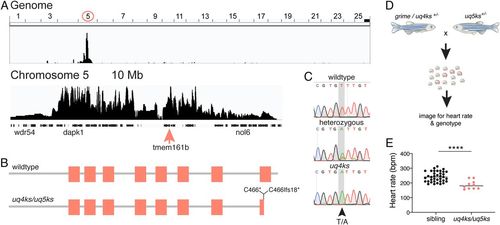
The arrhythmia phenotype in grime is caused by mutation of the tmem161b gene. (A) Positional cloning of grime by whole-genome sequencing mapping shows homozygosity on chromosome 5, and bioinformatic prediction identified a truncating mutation in transmembrane protein 161b, within the linked region (pink arrow). (B) Protein schematic of wild-type Tmem161b (above) and mutant alleles (below). The location of the grime/uq4ks mutation (C466*) and the CRISPR-Cas9-generated uq5ks allele (C466Ifs18*) is indicated. (C) Sequencing reads from wild-type, heterozygous, and homozygous tmem161buq4ks animals. (D) Experimental setup of complementation assay using a grime/uq4ks carrier and CRISPR-Cas9-generated uq5ks allele. (E) Quantification of progeny from complementation assays show that tmem161b heterozygosity fails to complement grime. Compound heterozygotes (uq4ks/uq5ks) have a reduced heart rate compared with siblings at 2 dpf, confirming that mutation of tmem161b is causative of the cardiac arrhythmia phenotype. n = 37 siblings, 10 compound heterozygotes; ****P < 0.0001.
|

